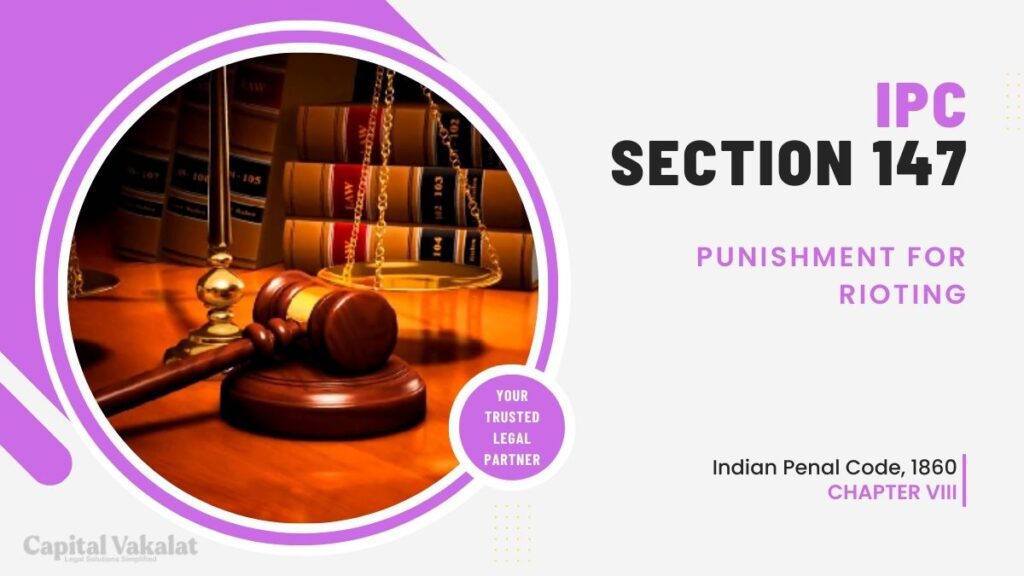Rioting is a social menace that often leads to chaos, violence, and a breakdown of law and order. In India, the Indian Penal Code (IPC) addresses this issue under Section 147.

This article explores the provisions, punishments, and implications of Section 147 IPC.
Understanding Section 147 IPC
Section 147 of the IPC defines the offense of “rioting.” It is a group offense where three or more individuals engage in violence or tumultuous behavior. Rioting can be a serious criminal charge, and understanding its elements is essential.
Elements of Rioting Under Section 147
To be charged under Section 147 IPC, several key elements must be met. These include the presence of at least three individuals, their common intent to engage in violence, and the use of force or violence. Additionally, the act must disturb the public peace.
Punishment for Rioting
The punishment for rioting under Section 147 IPC can vary depending on the severity of the act. Those found guilty may face imprisonment and fines. The duration of imprisonment and the amount of the fine can differ based on the harm caused and the gravity of the act.
Rioting in Indian Legal Context
Rioting is a prevalent issue in India, often triggered by religious, political, or social conflicts. It not only poses a significant threat to public safety but also hampers the social fabric of the nation.
Notable Rioting Cases
Several high-profile rioting cases have shaken India in recent years, highlighting the importance of understanding Section 147 IPC and its implications. These cases serve as reminders of the repercussions of participating in riots.
Legal Defenses Against Section 147 Charges
Defending oneself against charges under Section 147 IPC requires a thorough understanding of the law. Effective legal strategies can include demonstrating lack of common intent or proving that the accused was not part of the rioting group.
Relevance of Section 147 IPC
The existence of Section 147 IPC is crucial to maintain law and order in India. It serves as a deterrent against riotous behavior and provides a legal framework for dealing with those involved in riots.
Criticisms and Controversies
The application of Section 147 IPC has not been without controversy. Critics argue that it can be misused to suppress dissent and that the punishment may not always fit the crime.
The Role of Media
Media plays a significant role in shaping public opinion about rioting cases. The way events are reported can influence public perception and the legal outcomes of these cases.
Social and Political Implications
Rioting often has far-reaching social and political implications. It can lead to communal tensions, political conflicts, and a breakdown of trust in society.
Reform and Amendments
In recent years, there have been calls for reforms and amendments to Section 147 IPC to address its shortcomings and ensure that it is applied fairly and justly.
Conclusion
In conclusion, Section 147 IPC is a vital legal provision that deals with the offense of rioting. It serves as a deterrent against violent and tumultuous behavior and plays a significant role in maintaining law and order. However, its application is not without controversies, and there is a need for a balanced approach to ensure justice.
FAQs
What are the elements of rioting under Section 147?
The key elements of rioting under Section 147 IPC include the presence of at least three individuals, their common intent to engage in violence, and the use of force or violence that disrupts public peace.
What are the punishments for rioting in India?
The punishments for rioting in India can vary, with imprisonment and fines as common penalties. The severity of the punishment depends on the nature and impact of the riot.
Can Section 147 IPC be misused?
Yes, like many legal provisions, Section 147 IPC can be misused. It’s essential to ensure that its application is fair and just, and legal safeguards are in place to prevent misuse.
How does the media influence public perception of rioting cases?
The media has a significant influence on public perception. The way events are reported can shape opinions and affect legal outcomes. Biased or sensationalized reporting can exacerbate tensions, while responsible journalism can help maintain a balanced view of the situation.